Dragon Quest VII: Fragments of the Forgotten Past (Nintendo 3DS) Review
By Rudy Lavaux  13.09.2016
13.09.2016

It has been stated time and time again at Cubed3 that it's not favourable when games take years to come out of Japan. The tantalising prospect of potential localisations is always pure torture as players are left in the unknown for the longest of times, wondering whether or not the most exciting pieces of software will be localised or not, and this holds mostly true for role-playing games. Dragon Quest VII: Fragments of the Forgotten Past is one such prime example. Released back in February 2013 in Japan, it took three and a half years to make its way to the rest of the world and, as a matter of fact, counting the fact that it had never been released in Europe before, European players have had to wait 16 years since the original Japanese PlayStation version. Factoring in the iOS and Android English releases of the original trilogy (those games remain unreleased in Europe for consoles), Dragon Quest VII for the Nintendo 3DS marks the day that, at last, Europeans finally have access to the whole series in an officially localised way. Therefore, it is with great excitement and high expectations that Cubed3 dives into it.
The premise is very simple; the hero plays a hero (named by the player) who lives on a lonely island, said to be the only island in existence in the vast ocean, and regularly sets out on adventures around this little world with his best friend Kiefer, who also happens to be prince of the small, only kingdom in the world. Both of them are persuaded that the island cannot be the only place there is, however, and their adventures in the ruins found across their little piece of land soon proves them right when they discover that a nearby temple contains pedestals that, when certain fragments of stone tablets are placed upon them, teleport them to different places not found on their island where they have all sorts of adventures, followed around by the nosy Maribel.
She is daughter to the mayor of Pilchard Bay, where the hero normally lives. Visiting those different islands and solving whatever problem that seems to be boiling up there, makes that particular island reappear in the world the party hails from. Indeed, it soon becomes obvious that the places they teleport to are not only somewhere else, but also in a different, past time era. Preventing whichever disasters that made those islands disappear in the first place means that they are no longer gone in the present. As a result, the primary goal of the party of three heroes, which eventually welcomes three more for a total of six playable characters, will be to gather fragments of tablets scattered all around the world, including on those lost islands, to gain access to more places, save them from the terrible fate, and restore the world to what it should have been if not for those disasters.
It all plays out in a very classic RPG fashion. The original PlayStation version introduced the series to 3D locations inhabited by 2D sprites, a style that was later re-used for the three DS remakes of the second trilogy, to great effect. On the 3DS, however, everything is made in 3D and, while it still uses the rotating 3D environments found in the original and the DS remakes, the presentation is more in line with the Japan-exclusive PS2 remake of Dragon Quest V. Battles are now not completely random anymore but, rather like in Dragon Quest IX, enemy encounters now appear on the map and inside dungeons represented by enemy models moving around, so there is a small margin for avoiding battles altogether, which is a welcome bit of modernisation on Square Enix's part. Battles themselves, though, still play in the purest classic turn-based fashion, with turns being determined by the speed of each character, and actions being selected from a menu beforehand.
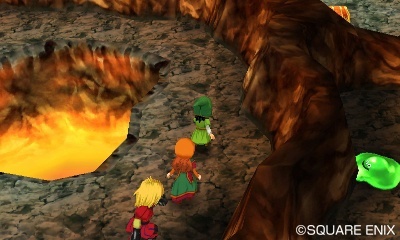
Enemies are now fully 3D modelled, unlike the original, and the party can be seen in battle from an above the shoulder camera angle, jumping forward at enemies and performing whatever move the player decides, giving battles a more dynamic feel than before, although not quite the same experience as in Dragon Quest VIII or IX. Naturally, this being an early 3DS game over in Japan, stereoscopic 3D is present throughout. This was indeed originally released at a time when Square Enix would prefer using it than abandoning it altogether in favour of more detailed, non-stereoscopic 3D graphics like it did with Final Fantasy Explorers, and the upcoming Dragon Quest VIII 3DS remake. 3D helps give more presence to the game world inside the screen, never using pop out effect but preferring a depth effect.
The whole thing, however, does suffer from occasional dips in frame-rate, whether 3D is turned on or not. This happens mostly when roaming the wide open 3D environments of the world map. It seems indeed that on the inside, the game actually always runs in 3D, constantly rendering two fields, one for each eye, but displaying both only when the 3D depth slider is pushed up, since 3D being on doesn't make things worse at all, which is a different approach to what Nintendo would do, where 3D being off means that the freed up resources can be used to apply a nice anti-aliasing effect, as witnessed, for example, in the Zelda remakes. This is not the case here, so aliasing is present in permanence, which is regrettable, although each and every scene remains pleasant to the eye nonetheless.
What truly makes the game come to life, anyway - as was very much the case in the original - is the dialogue. Most Dragon Quest adventures are known to never skimp on written conversations and this has always held true even in localised form. When Final Fantasy releases would see huge chunks of dialogue and story detail thrown down the drain in the 8-bit era during translation, Dragon Quest would very much keep a detailed and rich style of writing that still transpires to this day in this seventh instalment. VII was the first episode to introduce party conversation, too, where the hero can listen to reactions to current events from his partners at most times. This can be reacting to progress being made through the current sub-plot, giving subtle hints to what to do next, or it can be witty lines in reaction to a line of dialogue from the parents of the hero being addressed, such as "Your dad is so cool! My own could take a leaf or two out of his book... or make it the whole book!"
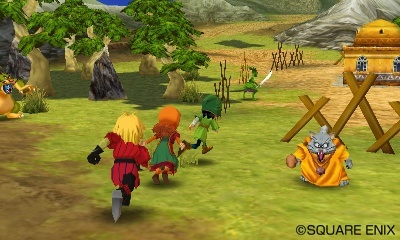
It helps give what is otherwise a very simply presented title - even more so in the case of the original version - a life of its own that makes the world inside the screen more credible and it helps that the characters are very loveable, as well. The whole game, however, progresses very slowly. Be warned, it is a very long adventure that moves at a rather slow pace. There is a lot to explore, lots of little houses full of cupboards and drawers to search, and pots and barrels to break in search of treasure that is not at all compulsory to make the story progress, but by which the player will inevitably let themselves be sidetracked.
Levelling up is also a rather slow process. Definitely plan on more than an hour of regular gameplay per level-up, but level grinding never really proves to be a necessity to move the main plot forward. A job system is present, too, which enriches the experience even further, using a totally separate levelling system for each character class, yet the process of levelling up was revised to be made quicker in this remake. There are a lot of different character classes of different types - human and monster classes - that help gamers gain knowledge of more spells and battle techniques that prove very useful but, again, the way it works was largely revised during its transition to handheld form, such as characters now having their appearance in and outside of battle changing upon changing classes, no matter what class is selected and no matter its current level. In fact, a lot of things were revised to be made more balanced or modernised.
It is still very much the same story and characters at its core, but brought up-to-date for more modern standards in some ways, like putting a map of each area on the bottom screen and making tablet fragments clearly visible on them, with a stone glowing on the bottom screen map when one is nearby and even a new character in-game helping find the more elusive ones. It still remains very classic at its core, however, and very much plays the Dragon Quest card of familiarity with its fans. It didn't push the PlayStation very hard in terms of visuals in its day, and while it hardly pushes the 3DS more when seeing what the handheld was capable of over the past five years, it still offers a very charming world filled with life and fun to be had.
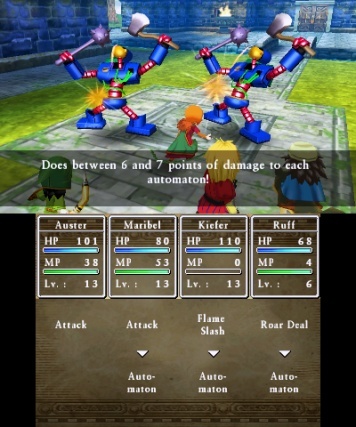
That is not to say that it does not do anything original for the series, but a lot of the things it does will seem like they have been experienced somewhere else in some other shape or form, like the possibility for the player to build its own town with characters found elsewhere in the world, reminding very much of Breath of Fire II, even though in the finer details, it naturally works differently this time around.
The thing it does that really feels the most original is perhaps its non-linearity. While most of the early parts of the journey will play in order, those in control will eventually find more tablet fragments for different maps, up to a point where certain areas don't have to be tackled in any specific order. Naturally, with certain fragments being found in other areas that have to be unlocked first, there are indeed some areas that will have to be cleared in first, and this helps the designers put the stronger monsters in areas that could not be tackled first, too, but where the player's hand is carefully held at first, it is progressively released in favour of some more freedom of exploration. Then, of course, as always, every Dragon Quest game tantalises the player with chests being in plain sight but locked behind locked doors or inside locked chests that won't be unlocked until much later, so there is a decent amount of totally optional backtracking and memorisation required, too, to complete everything.
Dragon Quest VII was decidedly a very long adventure on PlayStation already, and remains, very much so in this port, possibly the longest RPG on the handheld to date, bar perhaps the New 3DS version of Xenoblade Chronicles, taking well over 100 hours of gameplay at the very, very least to complete absolutely everything. Even then, a bonus dungeon has been added, a different set of optional areas are unlockable by collecting new stones that contain new pieces of armour not found in the original, and so on. Some would be fooled into thinking that it does not suit a handheld experience then, but a Quick Save feature, which allows the suspension of the adventure at any time (Quick Saves are permanent, too, and don't disappear upon loading), helping make the adventure an easy one to sample, even in shorter sessions, showing that Square Enix did give thought to gamers that play their 3DS on the go a lot. Squaresoft and Enix were the kings of the RPG in the past, and then they became perhaps a bit less so after their merging in the early 2000s, and have grown perhaps more into a remake factory, but remakes like these, especially for players who never could experience the original like those in PAL territories, are always welcomed with open arms.

Cubed3 Rating
Exceptional - Gold Award
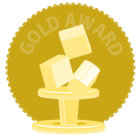
It is hard to make an RPG as classic as Dragon Quest VII. The series is known for not trying vastly different things in its mainline entries, rather sticking to a strict established formula that never disappoints its most hardcore fans, especially in Japan where it remains the absolute favourite role-playing experience for most. It is long and it moves slowly with its story, with lots of things to see and do on the side, and levelling up being very slow; however, it never gets boring and manages to hook players with a loveable story and characters served masterfully through witty dialogue, good visuals (if not technically very impressive), and a fantastic soundtrack by maestro Sugiyama-san. It feels very classic in its execution, yes, but the relative non-linearity and all things loveable about the game mentioned previously do contribute to making the long adventure a pleasant trip that never grows tedious. Fragments of the Forgotten Past is a great RPG through and through, masterfully remade for the 3DS, that offers what is perhaps the best value for money on the system in terms of RPG adventuring.
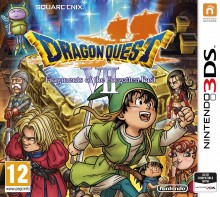
![]() 9/10
9/10
![]() 0
(0 Votes)
0
(0 Votes)
 Out now
Out now  Out now
Out now  Out now
Out now  Out now Also on
Out now Also on 
Comments
Comments are currently disabled

 Sign In
Sign In Game Details
Game Details Subscribe to this topic
Subscribe to this topic Features
Features





 Top
Top

